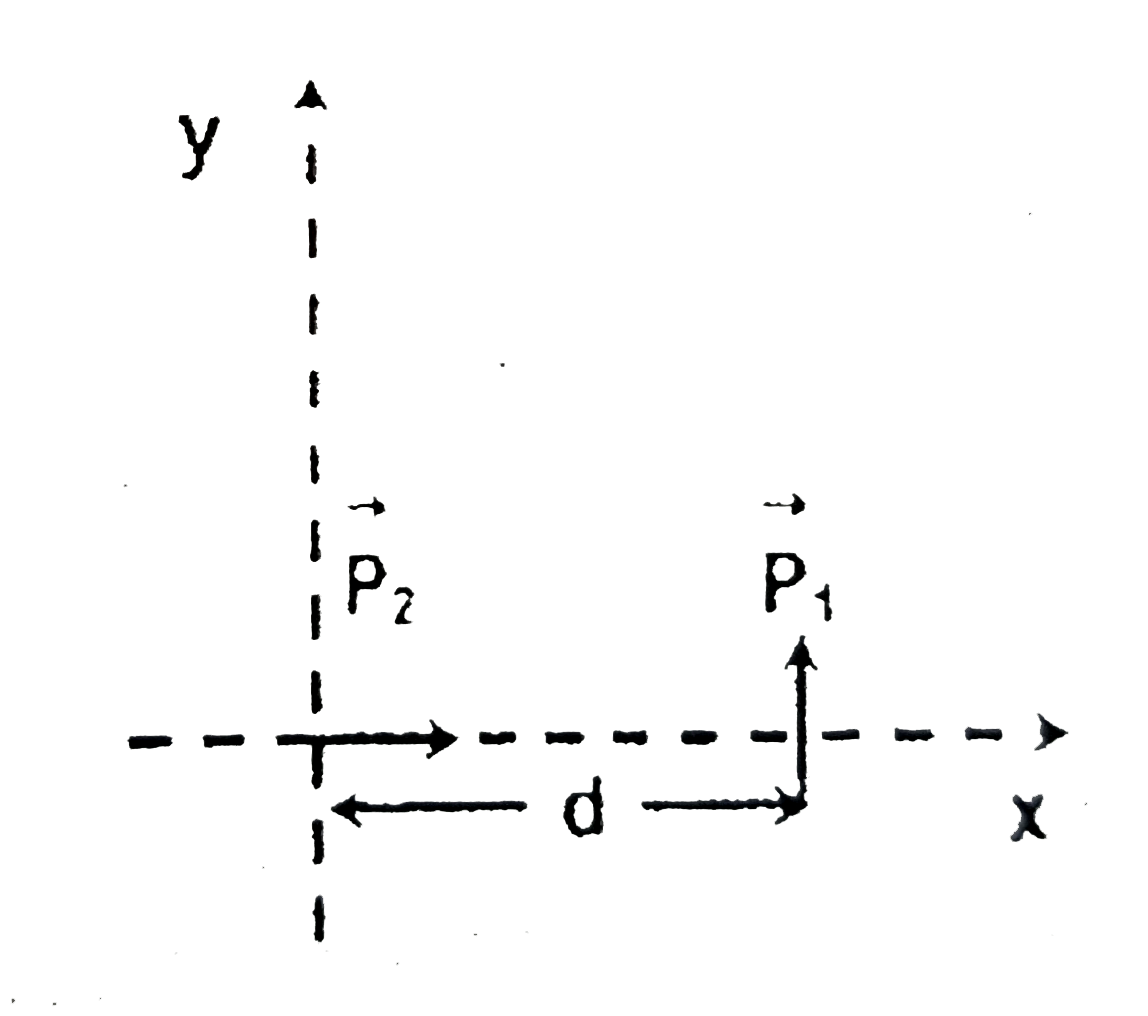Two balls having linear momenta →p1=pˆi and →p2=−pˆi, undergo a collision in free space. There is no external force acting on the ball. Let →p′1 and →p′2 be their final momenta. Which of the following option(s) is (are) NOT ALLOWED for an non zero value of p,a1,a2,b1,b2,c1 and c2.
→p′1=a1ˆi+b1ˆj+c1ˆk,→p′2=a2ˆi+b2ˆj
→p′1=c1ˆk,→p′2+c2ˆk
→p′1=a1ˆi+b1ˆj+c1ˆk,→p′2=a2ˆib2ˆj−c2ˆk
→p′1=a1ˆi+b1ˆj,→p′2=a2ˆi+b1ˆj
The correct Answer is:A, D
To solve the problem, we will apply the principle of conservation of momentum. Let's break down the steps:
Step 1: Understand the Initial Momentum
The initial momenta of the two balls are given as:
- →p1=p^i
- →p2=−p^i
The total initial momentum of the system is:
→pinitial=→p1+→p2=p^i−p^i=0
Step 2: Apply Conservation of Momentum
Since there are no external forces acting on the system, the total momentum before the collision must equal the total momentum after the collision:
→pfinal=→p′1+→p′2=0
Step 3: Analyze the Final Momentum
From the conservation of momentum, we have:
→p′1+→p′2=0
This implies:
→p′1=−→p′2
Step 4: Evaluate the Options
Now, we will evaluate each option to see which ones are NOT allowed given that a1,a2,b1,b2,c1,c2 are all non-zero.
Option 1:
→p′1+→p′2=a1^i+a2^i+b1^j+b2^j+c1^k=0
This implies:
- a1+a2=0
- b1+b2=0
- c1=0
Since c1 cannot be zero (given that all values are non-zero), Option 1 is NOT allowed.
Option 2:
c1+c2=0
This allows for c1=−c2, which is possible even if both are non-zero. Thus, Option 2 is allowed.
Option 3:
a1+a2+b1+b2+c1−c2=0
This can be satisfied even if a1,a2,b1,b2,c1,c2 are all non-zero. Thus, Option 3 is allowed.
Option 4:
a1+a2+b1+b2=0
Here, a1+a2 can be zero if a1=−a2 and b1+b2 can also be zero. However, since b1 and b2 cannot both be zero, Option 4 is NOT allowed.
Conclusion
The options that are NOT allowed are:
- Option 1
- Option 4
The initial momenta of the two balls are given as:
- →p1=p^i
- →p2=−p^i
→pinitial=→p1+→p2=p^i−p^i=0
Since there are no external forces acting on the system, the total momentum before the collision must equal the total momentum after the collision:
→pfinal=→p′1+→p′2=0
From the conservation of momentum, we have:
→p′1+→p′2=0
This implies:
→p′1=−→p′2
Now, we will evaluate each option to see which ones are NOT allowed given that a1,a2,b1,b2,c1,c2 are all non-zero.
→p′1+→p′2=a1^i+a2^i+b1^j+b2^j+c1^k=0
This implies:
- a1+a2=0
- b1+b2=0
- c1=0
c1+c2=0
This allows for c1=−c2, which is possible even if both are non-zero. Thus, Option 2 is allowed.
a1+a2+b1+b2+c1−c2=0
This can be satisfied even if a1,a2,b1,b2,c1,c2 are all non-zero. Thus, Option 3 is allowed.
a1+a2+b1+b2=0
Here, a1+a2 can be zero if a1=−a2 and b1+b2 can also be zero. However, since b1 and b2 cannot both be zero, Option 4 is NOT allowed.
The options that are NOT allowed are:
- Option 1
- Option 4
Topper's Solved these Questions
- BOOK - CENGAGE PHYSICS ENGLISHCHAPTER - CENTRE OF MASSEXERCISE - AR_TYPE1videos
CENTRE OF MASS
- BOOK - CENGAGE PHYSICS ENGLISHCHAPTER - CENTRE OF MASSEXERCISE - LC_TYPE3videos
CENTRE OF MASS
- BOOK - CENGAGE PHYSICS ENGLISHCHAPTER - CENTRE OF MASSEXERCISE - SCQ_TYPE12videos
CENTRE OF MASS
- BOOK - CENGAGE PHYSICS ENGLISHCHAPTER - CALORIMETRYEXERCISE - Solved Example13videos
CALORIMETRY
- BOOK - CENGAGE PHYSICS ENGLISHCHAPTER - DIMENSIONS & MEASUREMENTEXERCISE - Integer2videos
DIMENSIONS & MEASUREMENT
Similar Questions
Let (a1,b1) and (a2,b2) are the pair of real numbers such that 10,a,b,ab constitute an arithmetic progression. Then, the value of (2a1a2+b1b210) is
View SolutionLet →p=3ax2ˆi−2(x−1)ˆj,q=b(x−1)ˆi+xˆj and ab<0. Then →p and →q are parallel for:
View SolutionTwo dipoles →P1 and →P2 are oriented as shown in the figure. Assuming dipole of dipole moment →P2 to be placed at origin and dipole of moment →P1 is at a distance 'd' from origin then
 View Solution
View SolutionIf two equation a1x2+b1x+c1=0and,a2x2+b2x+c2=0 have a common root, then the value of (a1b2−a2b1)(b1c2−b2c1), is
View SolutionLet →a=a1ˆi+a2ˆj+a3ˆk,→b=b1ˆi+b2ˆj+b3ˆk and →c=c1ˆi+c2ˆj+c3ˆk be three non- zero vectors such that →c is a unit vectors perpendicular to both the vectors →a and →b. If the angle between →a and →b is π6 then
∣∣ ∣∣a1a2a3b1b2b3c1c2c3∣∣ ∣∣2 is equal toView SolutionIf the quadratic polynomials defined on real coefficient
P(x)=a1x2+2b1x+c1 and Q(x)=a2x2+2b2x+c2 take positive values ∀x∈R, what can we say for the trinomial g(x)=a1a2x2+b1b2x+c1c2 ?View SolutionLet ABC and AB'C be two non-congruent triangles with sides BC=B'C=5, AC=6, and ∠A is fixed. If A1 and A2 are the area of the two triangles ABC and AB'C, then the value of A21+A22−2A1A2cos2A(A1+A2)2 is
View SolutionIf the momenta of two particles of a system are given by →p1=2ˆi−ˆj+3ˆk and →p2=−ˆi+2ˆj−2ˆk then calculate the angle made by the direction of motion of the system with positive x-axis.
View SolutionIf a1anda2 are two non- collinear unit vectors and if |a1+a2|=√3, ,then value of (a1−a2).(2a1−a2) is
View SolutionIf a1anda2 aare two non- collineaar unit vectors and if |a1+a2|=√3, ,then value of (a1−a2).(2a1−a2) is
View Solution
